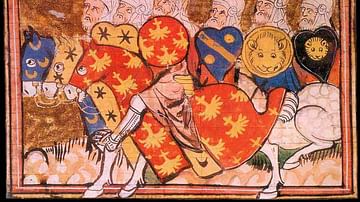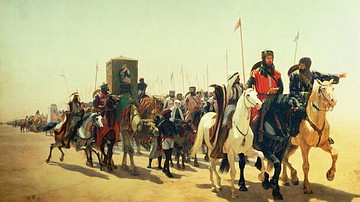Jerusalem, a holy city for the adherents of all three great monotheistic religions (Judaism, Christianity, and Islam) was conquered by the armies of the First Crusade in 1099 CE. The Muslims failed to halt their advance, as they were themselves disunited and disorganized, but this was soon to change and the Holy City was to be retaken. Saladin (l. 1137-1193 CE), the Sultan of Egypt and Syria, who united the core of the Islamic Empire under his domain prepared to strike back. He utterly vanquished the Crusader field army at the Battle of Hattin, in 1187 CE, and took Jerusalem later that year. Saladin's triumph was, however, far less violent than that of the medieval knights of the First Crusade (1095-1099 CE), and for this, he has been endlessly romanticized by Muslims and Christians alike.

Prelude
The rise of the Seljuk Turks in the 11th century CE crushed the status quo established in Asia Minor. Most of Anatolia was lost to the steppe warriors who had come to settle in this pastureland from central Asia. Although the Turkish princes were chivalrous, their soldiers were extremely brutal and often undisciplined - committing the most horrendous of war crimes on their own accord. In 1071 CE, the hope of restoring Byzantine authority over the region was shattered when a Byzantine army was crushed at the Battle of Manzikert. But the Turks soon fell from their glory and the mighty empire was carved up into smaller sultanates and independent states.
Byzantine emperor Alexios I Komnenos (r. 1081-1118 CE) was determined to reverse the setbacks of his predecessors. He appealed the Papacy for assistance, probably seeking a mercenary force subject to his personal control, but the result was beyond his wildest imagination. Pope Urban II (r. 1088-1099 CE) responded to the emperor's appeal and called a council at Clermont, a village in France, where he addressed a gathering of European nobilities and clergy. He used spiced-up and exaggerated tales (with a bit of accuracy) of the sufferings of their fellow Christians in the Holy Land, and preached a holy war against the "infidels" (Muslims), in return of which he offered complete plenary indulgence (remission of sins).
Stirred by the Pope's speech and motivated both by religious fervor and practical prospects, noblemen from all corners of Europe vowed to wrest the Holy Land from Muslim hands and embarked with armies on the First Crusade (1095-1099 CE) to the Levant. There they conquered Nicaea in 1097 CE (which was taken over by the Byzantines), Antioch, and Edessa in 1098 CE, and then proceeded to Jerusalem which fell in 1099 CE and was subjected to mass slaughter. Disunited Muslim princes made several futile attempts to halt the Crusader advance but suffered humiliating defeats at the hands of the organized and committed Crusader armies. The biggest shock to the Muslim world, however, resulted from the desecration of the Al Aqsa mosque, which was later converted to a church: the Temple Church.
Though lacking in strength to fight at that point, the Islamic front was preparing slowly and steadily to reclaim Jerusalem. The Islamic holy war or Jihad, long forgotten, was now revived for use against the Crusaders, and the standard was first raised by the Zengids (1127-1250 CE), a Turkish dynasty based in Mesopotamia and Syria. After the death of the second Zengid ruler, Nur ad-Din (l. 1118-1174 CE), the banner was taken up by his protégé: the Sultan of Egypt, Saladin (l. 1137-1193 CE). By 1187 CE, Saladin had spent over two decades of his life fighting the Crusaders, and it was this fateful year that would bring him the greatest triumph of his career.
Hostilities erupted between the two parties when a crusader knight, Reynald of Chatillon (l. c. 1125-1187 CE), attacked a Muslim trade caravan in defiance of the peace pact of 1185 CE put forward by his side. He imprisoned many, killed others, and when he was reminded of the pact, he mocked the Prophet Muhammad. In retaliation, the wrath of Saladin would engulf all that the Crusaders had achieved so far. On 4 July 1187 CE, the largest-ever Crusader army (although outnumbered by Saladin's forces) was crushed at the Battle of Hattin and the Holy Land lay undefended.

Taking the Levantine Coast
The pulverizing defeat at Hattin had left most of the Crusader strongholds without enough soldiers to defend them. And since the threat of a Crusader counterattack had vanished, Saladin scattered his forces to take the Levantine coast. The strongholds fell, mostly in an eventless manner; in many cases, local Muslim and Jewish populations rebelled and kicked the Crusader forces out, welcoming the Ayyubid armies to the undefended cities. Historian A. R. Azzam narrates as follows:
He decided to dispatch his commanders, 'like ants covering the whole face of the country from Tyre to Jerusalem', to the corners of the kingdom. Nazareth fell to Keukburi (Gokbori), and Nablus to Husam al-Din. Badr al-Din Dildrim took Haifa, Arsuf and Caesarea, while al-Adil took Jaffa. Saladin then sent Taqi ul-Din, his most capable commander to seize Tyre and Tibnin… (185)
Tibnin fell, but it was Tyre that should have been the first target of Saladin; this tactical error returned to haunt him later on in the Third Crusade (1189-1192 CE). Crusaders, from all corners of the Latin Kingdom flocked to Tyre. After a failed attempt to negotiate a surrender of the city, Saladin moved towards Ascalon (the gateway to Egypt), taking Ramla, Ibelin, and Darum en route. Although the defenders were initially defiant, once Saladin besieged the city, they capitulated without a fight. Now, he sought to claim the most prized treasure of all, he knew it by no name other than Quds, the Holy City – Jerusalem.
At the Walls of the Holy City
Saladin wished not to delay taking the holy city lest this opportunity be lost, for he knew that the might of the whole Christendom would soon be set upon him. He met with delegates from the city outside Ascalon and offered generous terms of surrender: they could take all of their possessions and leave the city under the protection of an Ayyubid military escort. This offer was rejected, prompting the Sultan to offer even more generous conditions: they could carry on with their lives, unhindered by the Ayyubid forces, and if no army came to their relief within the next six months, they shall surrender the city under the same conditions. The delegates refused to accept this offer as well, stating that they would not surrender the city under any condition. Insulted, the Sultan decided to subject the Christians to the same fate the Muslim and Jewish residents of the city suffered in 1099 CE.

The Ayyubid army, determined to storm and sack the city, marched confidently towards it under the leadership of the Sultan himself. Their flags were visible on the western side of Jerusalem on 20 September. Since Jerusalem was lacking severely on manpower, Balian had to knight several men (and even children), but even then, the citizens stood no chance in a direct assault, their main hope was to hold the walls.
As the siege commenced, the walls and the tower were showered with arrows and pelted with rocks hurled from catapults and mangonels; siege towers were sent forward to take the walls but were pushed back forces that sallied out of the gate. This deadlock persisted for a few days until the Sultan realized his tactical error: not only was this area easily defendable, the sun faced directly at his fighters, and the blinding glare did not allow them to fight until noon had passed. He moved his siege force eastwards towards the Mount of Olives, where no nearby gates could be used for sorties. On 25 September, Saladin's siege force was positioned, ironically, at the spot from where the knights of the First Crusade had attacked the city 88 years ago. Indeed, this was an effective move, a breach was created in the wall just three days later by the Sultan's miners, and now the city could be assaulted.
The City Surrenders
Unable to defend the city any longer, Balian rode out to address the Sultan directly and offered a bloodless surrender of the city. His words have been reported by Stanley Lane Poole:
“O Sultan,” he said, “know that we soldiers in this city are in the midst of God knows how many people, who are slackening the fight in the hope of thy grace, believing that thou wilt grant it them as thou hast granted it to the other cities – for they abhor death and desire life. But for ourselves, when we see that death must needs be, by God we will slaughter our sons and our women, we will burn our wealth and our possessions, and leave you neither sequin nor stiver to loot, nor a man or a woman to enslave; and when we have finished that, we will demolish the Rock and the Mosque el-Aksa (al-Aqsa), and the other holy places, we will slay the Moslem slaves who are in our hands – there are 5,000 such, – and slaughter every beast and mount we have; and then we will sally out in a body to you and will fight you for our lives: not a man of us will fall before he has slain his likes; thus shall we die gloriously or conquer like gentlemen." (228-229)
Whether the threats were hollow or genuine, the speech hit its mark, Saladin, who had been blinded by rage over the insulting encounter with Crusader emissaries at Ascalon, decided to spare the city a bloodbath. He realized that he could not let harm befall the Islamic holy sites and Muslims – as he had championed himself as their guardian.

A period of 40 days was given for the residents to arrange for their ransom, but many failed to do so. Saladin's brother al-Adil, Balian of Ibelin, and many ameers (generals) of the Ayyubid army freed people on their own accord. As for Saladin himself, he announced that all elderly people, who could not afford their freedom were to be set free anyway. Moreover, he allowed all noblewomen to leave the city without ransom; the Queen of Jerusalem, Sybilla (r. 1186-1190 CE), was also given safe conduct to meet her husband, Guy of Lusignan (l. c. 1150-1194 CE), who was in Saladin's captivity.
The Sultan was also approached by a group of wailing women, who, upon inquiry, revealed themselves as dames and damsels of knights who had either been killed or held prisoners. They begged for the Sultan's mercy, and Saladin ordered for their husbands, if they were alive, to be released, and none of these women were enslaved. Saladin's kindness was later narrated in a praising manner by Balian's squire.

The Aftermath
The Al Aqsa mosque was purified, and the Crusader cross was torn down from it. The building was washed and cleaned, adjacent buildings that had encroached over its area were taken down, so were the numerous Crusader artifacts placed within the mosque. Oriental carpets were placed inside, and perfumes were sprinkled over every corner of it. A pulpit, prepared under the orders of Saladin's patron Nur ad-Din (who had wished to reconquer the holy city himself, but did not live long enough to do so), was placed by the Sultan in the mosque, symbolizing the completion of his master's dream. After 88 years, the Friday prayer was held in the mosque in congregation.

The fall of Jerusalem hit Europe like a shockwave. Many scholars, including William, the Archbishop of Tyre (l. 1130-1186 CE), considered Saladin as a form of divine punishment, others thought of him as a scourge. For the Muslims, however, this was the long-awaited success brought to them by their Sultan.
The Crusaders drew their field army from their strongholds, and with most of the Crusader army annihilated, nothing stood in the way of the Muslims. Tyre, the sole bastion of the Cross in the Holy Land, as noted earlier, became the center of resistance. Soon, a fraction of the remainder Crusader army, the ones who were not permitted inside Tyre, laid siege on Acre (1189-1191 CE). This was the stage for the arrival of the armies of the Third Crusade (1189-1192 CE) under Richard I of England (r. 1189-1199 CE) and Philip Augustus of France (r. 1180-1223 CE). Though parts of the Levantine coast were recovered by this expedition, Saladin's Jerusalem remained untouched.
Conclusion
The battle of Hattin and the subsequent conquest of Jerusalem can be collectively termed as Saladin's magnum opus. He had strived his entire life, spent his entire wealth, and dedicated his entire will for one single purpose: the reinvigoration of the Muslim cause in the Holy Land and the expulsion of the Crusaders. Though he failed to accomplish the latter, he did incur irreparable damage upon the Crusader cause.











